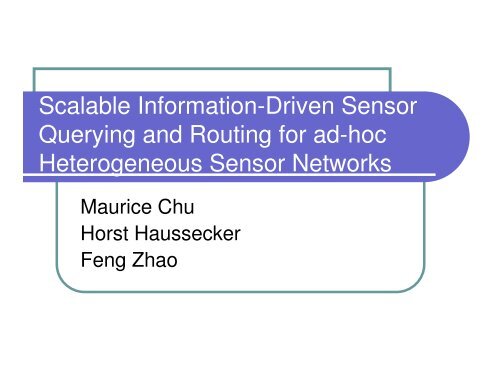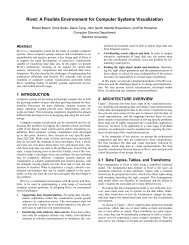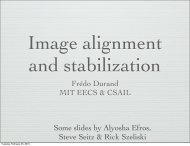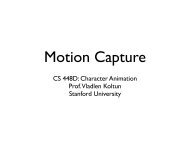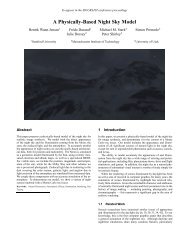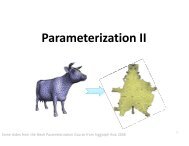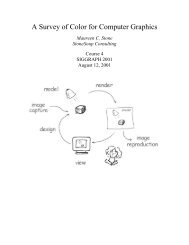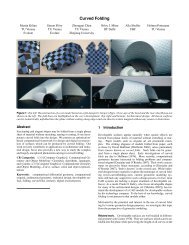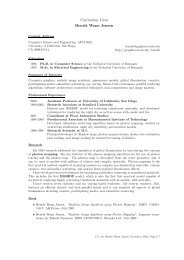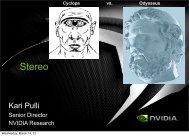Ali Ercan - Computer Graphics Laboratory
Ali Ercan - Computer Graphics Laboratory
Ali Ercan - Computer Graphics Laboratory
Create successful ePaper yourself
Turn your PDF publications into a flip-book with our unique Google optimized e-Paper software.
Scalable Information-Driven Sensor<br />
Querying and Routing for ad-hoc<br />
Heterogeneous Sensor Networks<br />
Maurice Chu<br />
Horst Haussecker<br />
Feng Zhao
Introduction<br />
Focus: sensor networks that are<br />
applicable to tracking and identification<br />
problems<br />
Necessities:<br />
Novel routing and<br />
Collaborative signal processing algorithms<br />
Key for scalability, low latency and<br />
energy awareness in large sensor<br />
networks
Introduction<br />
The paper presents 2 techniques:<br />
IDSQ<br />
CADR<br />
Information utility measure to select sensors<br />
Dynamically guide data routing<br />
Maximize information gain<br />
Minimize detection latency and BW consumption<br />
Minimize power consumption<br />
Generalization of directed diffusion
Sensing Model<br />
General form:<br />
Linear measurements:<br />
Acoustic sensors:
Estimation<br />
Blief:<br />
Estimate:<br />
Uncertainty:
Problem Formulation<br />
Querying a sensor is costly<br />
Thus sensor characteristics and<br />
measurements reside in the individual<br />
sensors<br />
Goal:<br />
Select good subset of sensors<br />
While reducing communication costs
Information Utility Measures
Information Driven Sensor Querying
Composite Objective Function<br />
Up till now, ignored communication cost<br />
Composite Objective Function:<br />
Eg.
Constrained Anisotropic Diffusion<br />
Routing<br />
Global knowledge of<br />
sensor properties:<br />
w/o global knowledge<br />
The node that locally<br />
maximizes M c<br />
Steepest gradient<br />
Composite<br />
Incremental updates<br />
Local computations
Experimental Results - IDSQ<br />
Sensor model:<br />
Leader is the<br />
centroid sensor<br />
Others selected<br />
one at a time by<br />
leader<br />
Sensor selection is<br />
performed:<br />
A. Nearest Neighbor<br />
B. Mahalanobis Dist.
Experimental Results - IDSQ
Experimental Results - CADR
Discussion<br />
Belief Representation<br />
Parametric – Gaussian<br />
Particle filters<br />
Updates:<br />
Kalman filter<br />
EKF<br />
Particle re-sampling
Conclusion<br />
A new approach to distributed, collaborative<br />
signal processing in sensor networks is<br />
presented<br />
Two key ideas outlined:<br />
IDSQ – Based on information gain<br />
CADR – Additional constraints (energy,<br />
communication)<br />
Incremental update of the belief<br />
Local computations<br />
Presented experimental results


